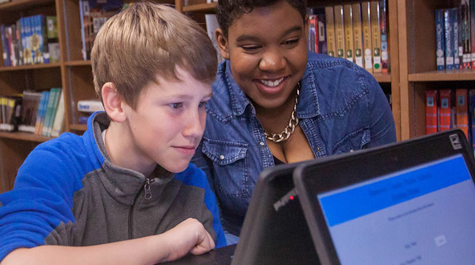Coding a next-gen high school
Amid a national conversation about what the next generation of high schools will look like, one new school in Richmond aims to redesign the high school experience, address inequities in STEM-related education and create a diverse workforce ready to fill the growing number of computer science jobs needed in the region.
CodeRVA, slated to open this fall, is a public regional high school that will combine blended instruction, real-world learning opportunities and guided career pathways with a special focus on computer science.
“We’re pushing the envelope in terms of what education looks like,” says Gail Hardinge M.Ed. ’85, Ed.S. ’89, Ed.D. ‘96, a clinical associate professor at the William & Mary School of Education and chair of the CodeRVA board. “And the more we do that, the more we can demonstrate to the commonwealth and to the country that public education can provide diverse learning opportunities and a variety of structures for students to enter the workforce or college.”
CodeRVA is designed on a blended instruction model, so students in the ninth and tenth grades will learn at their own pace through a combination of online learning, small group instruction and project-based learning opportunities. Juniors and seniors will pursue community-college coursework and paid internships with local firms in the computer science industry. Students will graduate with their high school diploma, an associate’s degree, computer science certifications, and significant real-world experience.
“We’re really focusing on competency rather than seat time,” says Hardinge. “Students’ learning will be individualized, with each student working at their own rate.” Teachers will closely monitor progress, both in the online portions and work-embedded aspects of the program.
An important goal of the program is to address the racial, economic and gender inequities in STEM education, an issue that has long been of interest to Hardinge. “All of the information on STEM careers indicates that we have a diversity issue in the field, so we’re committed to making this an inclusive program that reflects the demographics of the community we serve.”
CodeRVA was launched with a $50,000 high school innovation planning grant from the Virginia Department of Education. The grants, established in 2015, allow local school divisions to enact their own specifically-designed program, free from the usual regulations imposed on school divisions.
Virginia Superintendent of Public Instruction Steven R. Staples ’76, M.Ed. ’83 says the grants challenge school divisions “to think outside the box and develop nontraditional approaches to instruction, measurement of content mastery and school governance.”
CodeRVA was one of five programs to receive grants during the first round of funding in 2015, along with the Pathways Project, a partnership between Williamsburg-James City County Public Schools and William & Mary’s Center for Innovation in Learning Design. [Learn more about W&M’s work supporting the Pathways Project.] Both projects were also awarded implementation grants in 2016, an affirming boost that is allowing them to build momentum.
For Hardinge, the intersection of innovation and STEM education is a sweet spot. “This initiative gives us the opportunity to create a dynamic high school experience for our students and forge workforce partnerships that will benefit our region’s economy.” She adds, “It’s exciting to be on the leading edge of these changes.”
